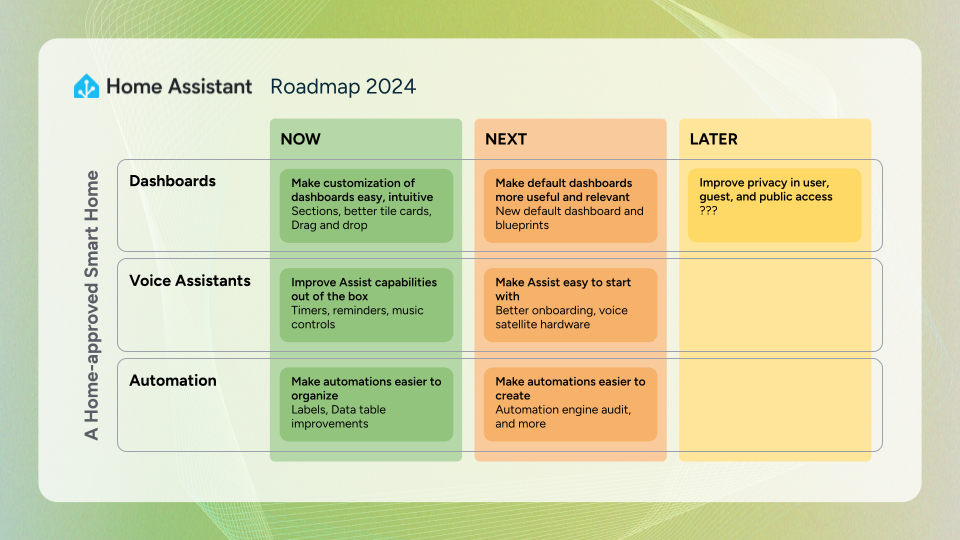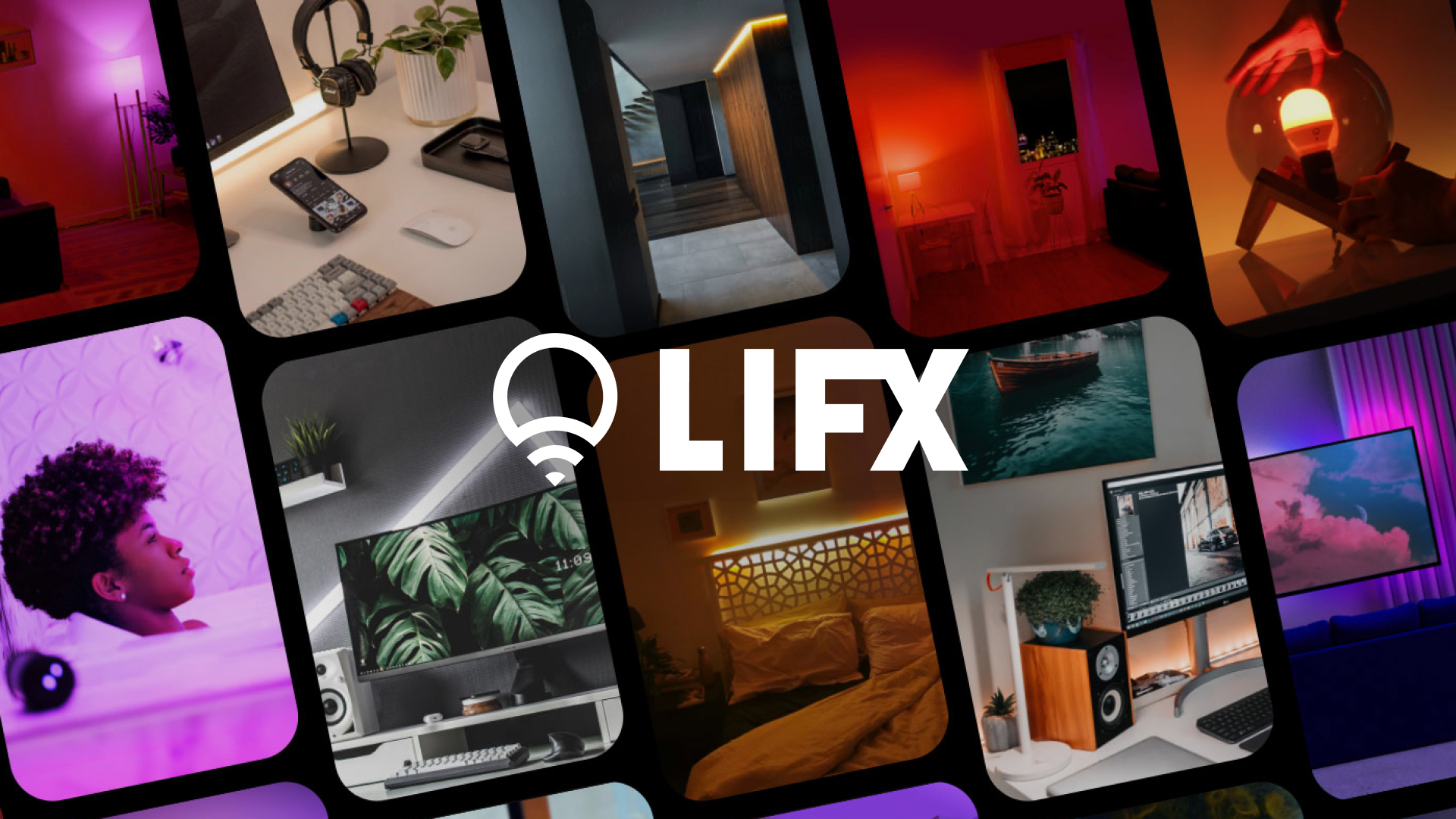During our State of the Open Home livestream in April, we presented our roadmaps for Home Assistant, open protocols, and Home Assistant Cloud. If you’re not sure what a roadmap is, or why we aren’t just listing features and dates – please read our intro to Home Assistant Roadmaps.
There has already been a lot of great discussion about these roadmaps in the community, and we would really like to encourage you to give your thoughts in the comments of this blog – as they will inform how the roadmap evolves over time.
You can skip straight to the sections you’re most interested:
~ Madelena & JLo
Big thanks to everyone who had given feedback to us throughout the entire process!
Home Assistant: “A Home-Approved Smart Home”

The mission of the Home Assistant project is to become the best smart home platform that embodies the Open Home vision (privacy, choice, sustainability), powered by a helpful open-source user community.
A smart home platform should allow users to observe, control, automate, and anticipate the key functions within a home, which provides safety, security, comfort, convenience, personalization, and accessibility to its residents.
Through our user research, we learned that while Home Assistant is a powerful platform for people who prioritize better privacy and customizability, we also found that adoption within their homes is another story. Our users have often gone to great pains to make Home Assistant easier to use for other members of their household, either by using another app as the user interface or hiding any visible traces of the platform altogether. We call the adoption of Home Assistant by other household members the “Home Approval Factor”.
Therefore, in the roadmap ahead for Home Assistant, we propose that our contributor community and us, the core maintainers, should focus our efforts on making Home Assistant more home-approved. This can be done by improving the touchpoints that all members of the household will interact with, such as automations, dashboards, and voice assistants, while maintaining the power and depth of the platform for our power users and admins. Our plan is divided into the following areas:
Dashboards
We have been hard at work renovating our dashboards since last year. Moving forward, we are focused on making the dashboard user experience better for all users.
Current priority: Make customization of dashboards easy and intuitive
With the new Sections view layout, better tile cards, and our incredibly well-received drag and drop 🐉, we have recently begun our work on making dashboard customization easy and intuitive. We aim to implement an intuitive and organized grid system for dashboards. We will need community contributions to update our current cards to fit the grid system.
Next priority: Make default dashboards more useful and relevant
Our current default dashboard gives our users two choices: Either list every entity the system is connected to or start from scratch. With dashboard blueprints, we know that we can make the default dashboards more useful than that. We will need your input to optimize them to display the most relevant information from the get-go.
Later priority: Improve privacy in user, guest, and public access
The inability to fine-tune access to Home Assistant by guests or other members of the family has been a pain point requested by many of our users. We want to investigate ways to mitigate this while improving the privacy of the household.
Voice assistants
Since last year, we have built our voice assistant framework from scratch with our “Year of the Voice” initiative. Now that the infrastructure is in place, we want to make sure that it will be usable for everyone (before the demise of Alexa and Google Assistant 😜).
Current priority 1: Improve Assist capabilities out of the box
Our research has shown users are most interested in us improving out-of-the-box capabilities of Assist, for instance, timers, reminders, and music controls.
Current priority 2: Make Assist easier to start with
At the moment, there are several things you need to install or configure to get started with voice. We want to make it easier to set up and onboard. There are already some good hardware choices to start using voice, but we’re exploring building our voice satellite hardware to create a more plug-and-play experience.
Automations
Automation is one of the cornerstones of the home automation industry. The ability to automate your home so that it does what you expect when you expect it is both fascinating and extremely rewarding for users, regardless of their experience level. Today, the automation engine of Home Assistant is one of the most powerful in the market. However, this comes at a cost: It is not the simplest to approach.
Current priority 1: Make automations easier to organize
As users grow their smart home, they will create more automation. Our automations are listed in a large table and can get easily disorganized as it grows. Earlier this year, we did a lot to improve the organization of automations, including labels, filters, and categories, which in return not only made automations easier to organize, but also almost every table in the Home Assistant settings.
Current priority 2: Make automations easier to create
While we made headway earlier this year in making automations easier to create, we need a more comprehensive effort with a full product development cycle of research, discovery, ideation, and validation to confidently make design and implementation decisions. As of now, many seemingly simple automations can be too complex to create and debug, and there is a lot of room for improvement. We foresee that when this opportunity is done, admins and housemates can easily create automations.
Research
To make informed product decisions, we need to base our work on solid research. Therefore, we have been building out our research capabilities, both in terms of user research and technology research.
User research
In order for all of us in our community to make the right product, design, and engineering decisions, we need all of us to have a clear picture of who our users really are. Last year, we did some initial research, mostly focused on dashboards. This year, we want to get the full picture with complete foundational research of our users.
Secondly, of the three Open Home values, privacy, choice, and sustainability, while we have a pretty solid understanding of choice and some understanding of sustainability, the idea of privacy can benefit from more clarity. We want a better understanding of what privacy really means to a home and its residents.
Technology research (R&D)
Yes, large language models (LLMs) are a hot trend, but that’s not why we’re exploring them. We know there are very interesting problems they can solve in the home, and with the amount of data our users collect in their history, we believe that there is much power underneath Home Assistant yet to be unearthed and it is uniquely positioned to be the smart home platform for AI. Our AI vision lays down the foundation for what we want to do with AI and LLMs next.
In order to help AI make better decisions, we need a better understanding of the context of what each device actually is. To do so, we need to refine our information architecture. For instance, we recently rolled out floors helping Home Assistant better understand your house. This is no small task, but it could be vital in implementing better voice or even AI in the home.
Home Assistant Cloud: “Peace of Mind”
Home Assistant Cloud, powered by our commercial partner Nabu Casa brings, to the many, the hard-to-reach features of Home Assistant usually reserved for power users with expensive hardware at home, with no compromise on privacy.
Currently, Home Assistant Cloud provides the simplest and safest way to access your Home Assistant instance anywhere in the world and connect to third-party cloud-connected voice assistants, like Google’s and Alexa’s offerings. Our newest ability added to Cloud is the ability to offload the resource-intensive tasks of speech-to-text and text-to-speech. This allows our users to have power-efficient hardware at home, like the Home Assistant Green, which uses three watts and performs tasks usually reserved for hundred-watt home servers.
For the next phase of Home Assistant Cloud, we want to continue to build features that adhere to our mission, as stated above. The theme for the upcoming initiatives revolve around providing peace of mind for our users:
Current priority: Hardening security
We want to harden our security, providing more control for remote access and Two-Factor Authentication (2FA) for your Nabu Casa account.
Next priority: Encrypted cloud backup
This would allow users to have a more resilient installation of Home Assistant, so if your instance completely breaks down, it can be restored from the cloud.
Later priority: Cloud monitoring
If your Home Assistant instance goes down, we’ll be able to detect it and send an email notification. This will allow you to monitor your downtime, and hopefully avoid more of it in the future, keeping your whole family happy 😁.
If you are currently a subscriber of Home Assistant Cloud, thank you again for your generous support of our project, and please let us know what we can do to improve our service. If you haven’t subscribed yet, you can check it out here!
Open standards: “Certified Quality”
We believe open standards are critical to providing choices for the future of the open home, and that is why we have put a lot of work into supporting current and emerging standards. They provide a way for manufacturers to provide broad compatibility, but they also provide peace of mind for users by ensuring the longevity of the devices.
All our teams are currently working very hard on certification – we want to make sure all our open standards implementations are up to industry standards.
Zigbee
For Zigbee, we already have a well-established hardware solution via our Home Assistant Connect ZBT-1 (formerly known as the SkyConnect). We continue contributing code and refining ZHA and Zigpy, the software powering Zigbee in Home Assistant.
Matter
Current priority 1: Certification
Matter is served via our Matter Server, which is evolving with the standard, and we will continue to the first home automation system that adopts the latest Matter standards. Our Home Assistant Connect ZBT-1 hardware also supports this standard via its support of Matter over Thread.
Current priority 2: Device Commissioning
There are still some big challenges that need to be addressed like device commissioning, which is currently overly complex, and we’re working with the industry to improve this.
Z-Wave
Current priority: Certification
This year, we made several big announcements with our support of Z-Wave. We joined the Z-Wave Alliance in February this year and have been working to improve our Z-Wave JS software.
Next priority: Home Assistant Connect Hardware for Z-Wave
To build the most seamless user experience for this protocol, we’re building our own Z-Wave stick to connect devices to Home Assistant. This new Z-Wave stick will join our Home Assistant Connect family of products.
What’s next?
Our roadmap is an open call for contributions in the product areas we are focusing on. It outlines what the core maintainers of the Home Assistant project will work on in the near future. This is a tool for our contributors and us, the project maintainers, to plan ahead for our collective future. As this is a living document, we will revisit and update our roadmap every half year.
For more information on how the roadmaps were created and how you can contribute, please check out this blog post here.





